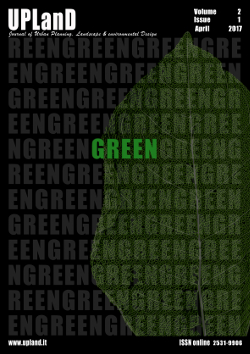Recreating nature in cities: a research program for the river’s renaturation in the Greater Lyon
Main Article Content
Abstract
From the 19th century, in Western Europe, urban sanitation was meant to create sewers as well as bury small rivers. With the impulse of environmental laws, engineering schemes that once aimed at shaping vegetation around the city is now trying to reintroduce it in the most natural way possible.
In that context, river restoration appears to be a strategic tool for the development of cities. It is also about linking districts to each other with plant pathways, creating public spaces, all while dealing with the issue of heat islands. River restoration designates the re-establishment of a river's natural functions, which used to be highly anthropized.
After a rhetorical review, the paper deals with the firsts results of Lyon’s river restoration research program. This research program is enacted by the Greater Lyon, the CNRS (National Centre for Scientific Research) and an engineering agency Artelia. The paper especially treats the subject of Rize’s restoration. A former river which was entirely buried in the 19th century. This study contributes to the research on the “shallow” concept of a sustainable city through the consideration of the benefits and shortcomings of recreating a river in a dense urban area.
Downloads
Article Details

This work is licensed under a Creative Commons Attribution-NonCommercial-NoDerivatives 4.0 International License.
Authors who publish with this journal agree to the following terms:- Authors retain copyright and grant the journal right of first publication with the work simultaneously licensed under a Creative Commons Attribution License that allows others to share the work with an acknowledgement of the work's authorship and initial publication in this journal.
- Authors are able to enter into separate, additional contractual arrangements for the non-exclusive distribution of the journal's published version of the work (e.g., post it to an institutional repository or publish it in a book), with an acknowledgement of its initial publication in this journal.
- Authors are permitted and encouraged to post their work online (e.g., in institutional repositories or on their website) prior to and during the submission process, as it can lead to productive exchanges, as well as earlier and greater citation of published work (See The Effect of Open Access).
References
Béthemont, J., Pelletier, J. (1990). Lyon et ses fleuves : des berges perdues aux quais retrouvés. Revue de Géographie de Lyon, vol. 65, 4, 300-307.
Bravard, J.-P. (2000). Les extrêmes hydrologiques : handicaps réductibles ou composantes patrimoniales à sauvegarder ? in Bravard, J.-P. (eds.) Les régions françaises face aux extrêmes hydrologiques, gestion des excès et de la pénurie, SEDES, Paris, 5-15.
Brun, A. (2015). The restoration of urban rivers : the example of Saint-Charles River in Quebec » in Quentin Grafton R., B. Ward M., Daniell K., Nauges C., Rinaudo J.-D., Wah Chan W., Understanding and Managing Urban Water in Transition, Springer, Dordrecht, 527-548.
Brun, A., Caltran, H. (2015). La renaturation des rivières urbaines : un nouveau chantier pour le Grand Lyon, Nature des villes, nature des champs. Synergies et controverses, 23-25 septembre 2015, Valenciennes, La Louvière, Belgique.
Brun, A., Coursière, S., Casetou, E. (2014). Eau et urbanisme à Lyon : le projet de renaturation du Ruisseau des Planches, Territoire en mouvement, [En ligne], 22 | 2014, mis en ligne le 15 juin 2014.
Caltran, H. (2013). Principes de fonctionnement écologique et définition des enjeux d’aménagement relatifs aux petites rivières urbaines du Grand Lyon, Champs-sur-Marne, Séminaire « Eau et Aménagement », PontsParistech, Champs-sur-Marne, 13 février 2013.
Carré, C. ed. (2011). Les petites rivières urbaines d’Île de France, Agence de l’eau Seine-Normandie, coll. « Programme interdisciplinaire sur l’environnement Seine », vol.11, 86 p.
Gérardot, C. (2004). Les élus lyonnais et leurs fleuves : une reconquête en question, Géocarrefour, vol. 79, n°1, 75-83.
Howard, E. (1902). Garden Cities of Tomorrow, Sonnenschein & Co, London.
Idarraga, F.L.F. (2010). Urban river restoration in Colombia. Building and Environment, Science and Technology Department, Politecnico di Milano, 313 p.
Lerner, J. (2014). Urban acupuncture. Island Press, Washington.
Mauch, C., Zeller, T. eds. (2008). Rivers in history, perspectives on waterways in Europe and North America, University of Pittsburgh Press, Pittsburgh.
Morandi, B., Piégay, H. (2011). Les restaurations de rivières sur Internet : premier bilan, Nature Science Société, vol. 19, issue 3, 224-235.
Morley, S.-A., Karr, J.-R. (2002). Assessing and restoring the health of urban stream in the Puget Sound Basin, Conservation Biology, 16, 489-509.
Pelletier, J., Delfante, C. (2004). Atlas historique du Grand Lyon. Formes urbaines et paysages au fil du temps, éditions Xavier Lejeune-Libris, Paris.
Scherrer F. (2004). L’eau urbaine ou le pouvoir de renaturer, Cybergeo : European Journal of Geography [En ligne], consulté le 08 06 2013, URL : http://cybergeo.revues.org/1496
Zedler, J.-B. (2000). Progress in wetland restoration ecology, Trends in Ecology and Evolution, 15, 402-407.

